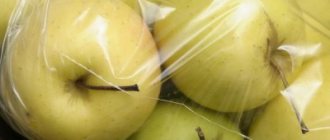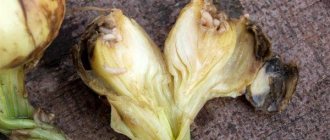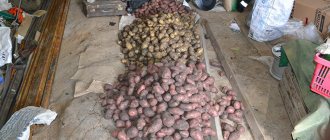To get a good potato harvest, you need to spend a lot of time and effort. But even during storage, there are unpleasant surprises - the tubers in the basement begin to mold and rot, as a result of which part of the stock has to be thrown away.
From potatoes, as well as from walls and ceilings, fungus can quickly spread to other products, and this shortens their shelf life. To get rid of mold in a potato cellar, you need to know what it looks like and what remedies are effective against it.
Mold on potatoes, what to do
Start monitoring the safety of the crop while the tubers are still in the ground. Mow potato tops a week before digging up the vegetable. This way you will prevent the fungus from getting through the stem to the tuber.
Before storing potatoes, thoroughly treat them to remove mold. A lime solution is perfect for this. Add a little one percent copper sulfate to it.
The storage location (basement, cellar) is also disinfected. For this purpose, smoke of dried herbs is used. You can use tansy or wormwood.
If, after all, the potatoes are covered with mold, then use safe methods for removing the fungus from the place where the vegetable is stored:
- Treatment of the premises. This “procedure” is performed using a quartz or ultraviolet lamp. Leave it on indoors for at least five hours.
- Removing mold from the walls, floor and ceiling of a room using a lime solution. At the same time, make sure that not a single drop gets on the potatoes during processing.
- Getting rid of infected tubers. Go through and inspect all the potatoes. If we find an “infection”, we safely throw it away.
- Reduced humidity. Provide the potato storage area with good ventilation. Dampness is the causative agent of mold. In addition to equipping the room with ventilation, you can place a small container with the same lime (quicklime) on the floor. It absorbs moisture very well. Sprinkle the tubers themselves with aspen chips or wood ash.
We invite you to familiarize yourself with Caramel: classification, assortment, storage
Diseases
Rotting is caused by some dangerous diseases: late blight, bacterial rot, black scab.
Late blight
The fungal disease appears as dark spots on the tubers. When cut, you can see that the black rot goes inside the potato.
Late blight occurs during the growing season, and is activated already in the cellar if the temperature exceeds the norm.
Basic control measures:
- potatoes are sorted, infected tubers are removed;
- normalize the temperature in the room;
- healthy vegetables are treated with biological products (for example, “Gamair”).
Potatoes are dug up only in sunny, dry weather and poured into boxes in a layer of about 1 m.
Wet bacterial rot
Tubers with this disease become covered within a couple of days with patches of gray mucus with a terrible smell. Temperatures above +20°C and humidity above 90% provoke the development of the disease.
To get rid of rot, do the following:
- the crop is sorted and rotten tubers are thrown away;
- normalize humidity and temperature in the cellar;
- diseased areas on vegetables are cut off, the cut area is treated with alcohol;
- The potatoes are inspected periodically.
Black scab
The fungal disease causes small black spots (sclerotia) and cracks on the tubers. Rhizoctonia does not affect the taste of vegetables and is usually associated with late harvest.
Attention! The scab is passed on to the next generation of the crop.
Disposal and prevention measures:
- tubers are sorted and damaged ones are thrown away;
- the crop is treated with Ditan M-45 (200 g per 5 liters of water, the solution is enough for 100 kg of potatoes);
- normalize storage conditions.
Other measures
There are several other ways to prevent mold from occurring when storing potato stocks:
- pour a layer of sand or lime on the floor under the vegetables;
- add rowan leaves to the potatoes - they release phytoncides that destroy putrefactive organisms;
- you can add branches of wormwood, which has an antimicrobial effect;
- It is recommended to store potatoes next to beets - this vegetable will serve as a moisture regulator, which will reduce the risk of tubers rotting.
Favorable conditions for reproduction
Why does mold appear in some cellars and not in others? For the appearance of “life” certain conditions are necessary:
- presence of spores in the air. They are transported and settle in the cellar on people, products, animals;
- nutrient organic medium (paper, wood, soil, peat pots);
- favorable microclimate (high humidity, temperature about 20 degrees). Poorly functioning or non-functioning ventilation also has a negative impact.
Some types of fungus have the ability to reproduce at temperatures of 0 degrees.
Pay special attention to the ventilation system. After all, it is designed for normal air circulation in the room. Air movement prevents mold spores from attaching to any surface. In the corners, air movement is difficult; this is where colonies of fungi often accumulate.
Ventilation helps remove excess moisture from the room, which occurs against the background of high humidity outside or a large difference in temperature. If there are fungal spores on the walls, but there are no favorable conditions for reproduction, they will not germinate. Based on this, we can conclude that poor ventilation is the main reason for the appearance of fungal colonies in the cellar.
How to get rid of food moths in the kitchen? Check out our selection of effective pest control methods.
Read about how and how to remove mold from a wall in an apartment at this address.
Precautionary measures
You can avoid allergic reactions and damage to the skin by taking the following precautions:
- Before starting to destroy mold, put on a protective suit, goggles and gloves;
- It is strictly forbidden to smell or touch dangerous microorganisms;
- after treating the room, leave it;
- It is strictly prohibited to eat products affected by mold.
Only by clearing the cellar of pathogenic microorganisms will you feel completely safe eating fresh and healthy foods.
Danger of fungus to humans
Not many people know that fungus, both directly and indirectly, can seriously affect a person’s well-being. A floor affected by fungus will fail sooner or later. As a result, serious injuries can occur. The same can be said about a ceiling that may collapse. This is what concerns wooden structures. Mold can affect human health by:
- Direct contact with human skin.
- Through the human respiratory and circulatory system.
- As a result of eating foods contaminated with fungus.
Many types of fungi have highly toxic spores. Mold multiplies very quickly: 1 square meter of fungal colony can release up to 1 billion spores into the air. Under favorable conditions, they can begin to develop in the human body, which can lead to various diseases.
Contact with mold can result in a variety of consequences. For example:
- Dermatological lesions of various parts of the body, especially the skin, as a result of allergic reactions.
- Damage to the upper respiratory tract, which results in nosebleeds, sinusitis, profuse runny nose, and difficulty breathing.
- Headaches and dizziness may occur.
- Problems with the gastrointestinal tract with attacks of nausea or vomiting.
- Exhaustion of the body, manifestation of anemia.
Prolonged human contact with mold can lead to problems with the kidneys and liver, as well as internal bleeding. Pulmonary emphysema is also possible. First of all, people with weakened immune systems suffer from such contacts. As a rule, these are children and the elderly, as well as people suffering from fungal diseases.
It is very important to know that mold allergy can be diagnosed in any laboratory. If it is determined that the cause of the allergy is a fungus, then measures must be taken immediately to detect and destroy it.
Preparing the premises
It is recommended to treat the cellar on warm and sunny days. It consists of several stages:
- Clean the room - remove plant debris; Treat shelves, pallets and drawers with soapy water and take them outside to dry.
- After the boards have dried (about a week), treat them with an antifungal agent, for example, a strong solution of potassium permanganate.
- Only a dry cellar is suitable for storing potatoes, so they are thoroughly dried and left open. This will take from 5-7 days to several weeks, depending on the condition of the storage facility.
- When the room is dry, treat the walls with antifungal and antibacterial agents. You can whiten the surfaces with a solution of lime with the addition of copper sulfate: for 10 liters of water you will need 2 kg of lime, 1 kg of vitriol and 100-150 g of ordinary salt. It is advisable to whitewash twice at intervals of a week.
- Treat the earthen floor with a solution of copper sulfate and let the product absorb.
- After this, you can bring in racks and drawers. The cellar is ready to store the new harvest.
Rules for storing potatoes
In most cases, potatoes begin to get wet and spoil in basements and cellars if the maintenance conditions are violated.
The rules for winter storage of potatoes in the cellar are as follows:
- The room must be prepared in advance. Storing is carried out only in a dry basement. To do this, it is left open for about 2 weeks. Particular attention should be paid to organizing good supply and exhaust ventilation and waterproofing. If the groundwater level is high, additional protection against moisture must be installed.
- It is necessary to clean the cellar or basement of old plant debris and carry out disinfection, which consists of disinfecting and antifungal treatment of the walls (apply a solution of Bordeaux mixture, lime and copper sulfate). Fumigation with sulfur bombs is effective. All boards and wooden parts need to be washed, dried and also treated.
- Before planting, potatoes should be sorted, discarding diseased and suspicious specimens.
- The temperature in the storage must be constantly maintained within +2…+7°C. Humidity should not exceed 70-80%. Conditions of detention must be regularly monitored and timely adjustments made.
Reasons for appearance
Mold never appears just like that; this event is preceded by other unfavorable circumstances:
- missing or clogged ventilation shafts. Lack of fresh air contributes to the growth of fungal colonies;
- increased level of air humidity, condensation accumulation. This aspect often depends on the first factor;
- insufficient air circulation in the cellar;
- storage of rotten fruits and vegetables. Spoiled products become sources of mold, spores actively spread throughout the room, settling on the walls, floor and ceiling;
- the use of wooden products that are contaminated with fungal spores.
How to use a sulfur bomb correctly
Detailed instructions for use of “Climate Sulfur Bomb” are written on the inside of the package. Before using the drug, you should definitely read it. Let's look at the most important points:
- Before using a sulfur bomb, clear the room of metal objects, as sulfuric anhydride can cause metal corrosion. If this is not possible, then lubricate all metal surfaces with a thick layer of fat or grease.
- Place the required number of sulfur tablets on any non-flammable surface (metal, ceramic) measuring 70x70 cm and 2-3 cm thick.
- Place the wick between the top tablets so that it is horizontal and protrudes beyond the tablets by 2-3 m.
- Light the wick and after making sure that it begins to smolder smoothly (translucent smoke and a pungent odor appear), leave the room.
- Close the door/hatch tightly and leave the cellar closed for 24-36 hours.
- Ventilate the room for 2 days. Ventilation can be completed only when the smell of sulfur dioxide completely disappears in the cellar.
All you have to do is put the cellar in complete order and fill it with the new harvest.
Effective methods of control
How to treat the cellar against mold and mildew? Removing mold is hard work that requires a lot of effort and time. It is necessary to take into account the causes of the problem. An integrated approach will help get rid of mold, similar to cotton wool, and prevent the re-growth of fungal spores in the cellar. The fight against fungal colonies is carried out in several stages, each of them is described in detail below.
Preparing to eliminate dangerous microorganisms
Helpful Tips:
- While processing the room, be sure to empty it of all objects, equipment and food. This way, you will provide excellent access to possible places where mold is localized, protect the products that are in the cellar;
- Remove all furniture and large objects from the room. They also need to be treated to avoid re-infection of the cellar with mold;
- do a general cleaning of the room. Clean off all mold; if fungal spores have penetrated deep into the finishing material, be sure to replace damaged structures with new ones;
- wood rots very quickly; if the floor is earthen, then approximately 20 centimeters of the soil layer must be removed (it is probably contaminated);
- After thoroughly treating the cellar, begin drying the room. Only then is it allowed to begin directly combating mold.
Why is it necessary to get rid of fungus and mold in the cellar?
First of all, the appearance of the cellar suffers. The room looks untidy if there is mold. In addition, over time, fungi partially destroy even concrete walls, so repairs to the affected areas will be required. Wooden elements often cannot be restored and must be replaced.
However, mold fungi can cause the greatest damage to human health. The danger comes from mold spores that enter the lungs through the air.
This is fraught with the following consequences:
- asthma;
- sinusitis;
- sinusitis;
- runny nose;
- migraine;
- pneumonia;
- gastrointestinal disorder;
- nausea and vomiting;
- nosebleeds;
- allergic reaction;
- dermatological diseases;
- exhaustion of the body;
- anemia.











